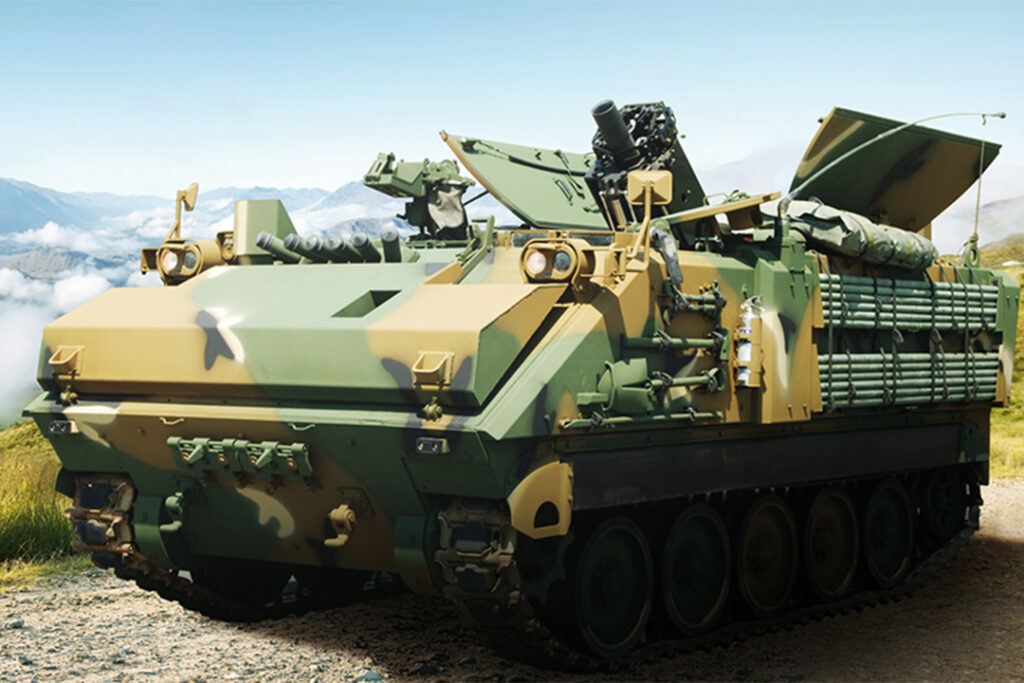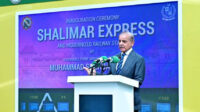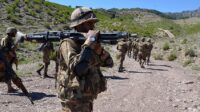Written by Major (R) Haroon Rasheed Strategic and Defense Analyst.
Pakistan’s new mobile 120 mm “shoot-and-move” mortar appears to emphasize rapid emplacement, digital fire control, crew survivability, and mobility. Compared with India’s widely fielded towed/man-portable 120 mm mortars (and a smaller set of experimental/limited vehicle-mounted solutions), Pakistan’s system offers a doctrinal advantage in shoot-and-scoot survivability and faster response in fluid tactical scenarios.
PM leaves for New York to attend 80th session of UNGA
Former Delhi batsman Mithun Manhas set to become the next BCCI president
Haris Rauf Taunts Indian Fans With 6-0 Gesture During Indo-Pak Match
For more such Opinions & Blogs, click here.
Representative technical specifications (Pakistan — new mobile system)
Weapon & Ammunition
Caliber: 120 mm (standard NATO/coalition caliber).
Ammunition types: high-explosive (HE), smoke, illumination, precision-guided/assisted (if available), programmable airburst (possible future upgrade).
Standard range (unassisted HE): 6.5–8.5 km.
Extended range with rocket-assisted or base-bleed rounds: up to 10–13 km.
Firepower & Rate
Maximum burst rate (short duration): 16–20 rounds/minute (while barrel and mount temperatures permit).
Sustained rate: ~6–8 rounds/minute (logistics-limited).
Effective lethal area per round: typical for 120 mm HE (large fragmentation and blast radius suitable for company-level suppression).
Mount & Mobility
Platform: vehicle-mounted — light-armoured 4×4 or mine-protected light tactical vehicle (typical choices: 4×4 pickup with armored cab, or purpose-built MRAPLAV variant).
Integration: recoil-absorbing mount, auto-locking cradle for immediate firing from vehicle or rapid dismount for ground-fire (if design allows).
Time to first fire from halt: under 60–120 seconds (goal: minimal).
Time to relocate after last round: under 30–90 seconds (shoot-and-scoot objective).
‘What’s Wrong with Shaking Hands?’: Azharuddin Rejects India’s Stance for Pakistan
Air India Express Flight, Flier Tries to Open Cockpit Door
Somalia-bound ship carrying rice and sugar catches fire at Indian Gujarat jetty
Fire control & sensors
Digital Fire Control System (FCS): ballistic computer, meteorological input, automated laying (electro-mechanical or hydraulic elevation/traverse), integrated ballistic tables.
Navigation & targeting: GPS/INS integrated for platform geo-registration, laser rangefinder, or target feed inputs from forward observers/unmanned aerial systems (UAS).
Network/C2: datalink to battalion-level artillery/infantry command nodes for rapid tasking and battle damage assessment.
Crew & Protection
Crew: 3–5 personnel (commander, gun layer/operator, ammo handlers).
Protection: armored cabin for crew; remote firing option possible to allow firing from protected position.
Ammunition storage: on-vehicle stowage with rapid-feed rack, typically carrying 12–30 rounds depending on vehicle size.
Logistics & Mobility
Road speed: matches host vehicle class (typically 100+ km/h on road).
Off-road mobility: moderate — designed to keep pace with mechanized infantry columns.
Sustainment: modular ammunition packs for quick reloads; resupply doctrine tied to battalion logistics.
Hamas official says state recognition a victory for Palestinian rights
DPM arrives in New York to attend UNGA session
80th Session of UNGA begins in New York today
Direct comparison of Typical Indian 120 mm mortar system — strengths & weaknesses
1. Mobility & survivability
Pakistan mobile system: High. Vehicle mounting + rapid shoot-and-move reduces vulnerability to counter-battery fire and drones.
Indian typical systems: Moderate for dismounted/towed mortars; vehicle-mounted examples exist but are less universally fielded.
Advantage: Pakistan (where mobile systems are widely integrated at lower echelon).
2. Response time and tempo
Pakistan: Faster time-to-first-round and quicker displacement; supports faster battle rhythms and fluid maneuver.
India: Dismounted/towed systems require setup/teardown time — slower tempo unless vehicle-mounted variants are deployed.
Advantage: Pakistan for shoot-and-scoot engagements; parity possible in formations that deploy vehicle-mounted mortars.
3. Fire-control and networking
Pakistan: Modern FCS and GPS/INS integration expected on new systems — allows faster, more accurate targeting, and easier integration with UAS and forward observers.
India: Upgrading; many units have digital solutions but at mixed scales across the force.
Advantage: Depends on the fielding scale; Pakistan’s new system likely provides a doctrinal leap at formation level.
Water flow in rivers of Punjab normal: PDMA
T20 Asia Cup: Pakistan to take on Sri Lanka on Tuesday
BSF adds drone warfare to raining curriculum, commissions innovation center
4. Munition and range
Both sides can achieve comparable ranges with modern mortar rounds and extended-range munitions. The real edge is in delivery (mobility + networking), not raw range.
Neutral: Comparable ammunition performance overall; operational effect depends on integration.
5. Industrial & doctrinal implications
Pakistan, producing an integrated mobile system, signals rising local engineering capability and an emphasis on tactical mobility. India’s large industrial base also develops such systems, but field adoption and doctrinal prioritization determine impact.
Operational significance — what this means tactically and strategically
1. Increased survivability of fire teams. Rapid displacement after firing reduces casualties from counter-battery fire and loitering munitions — a key advantage in modern contested environments.
2. Faster, decentralized indirect fire support. Company and battalion commanders will have near-instant indirect fires without waiting for divisional artillery, enabling faster, smaller-unit maneuver operations.
3. Better integration with ISR assets. A digital FCS tied to UAS, and forward observers shortens sensor-to-shooter time, enabling precision suppression and interdiction.
4. Psychological and deterrent effects. Mobile mortars complicate enemy targeting and reduce the value of intelligence that pins down stationary fire assets.
5. Industrial and export potential. A domestically engineered, field-proven mobile mortar platform is a credible export item for partner nations with similar terrain and doctrinal needs. It also demonstrates Pakistan’s growing ability to innovate beyond licensed manufacture.
President returns home after visit to China
7 Indian‑backed Khwarij Killed in Kulachi, D.I.Khan
President leaves for home after concluding visit to China
Caveats & near-term improvements to watch
Ammunition supply and logistics: Mobility is only as good as resupply. Adequate onboard ammo and fast resupply must accompany fielding.
Precision munitions adoption: Integration of guided or air-burst rounds significantly raises tactical value.
Counter-UAS and signature management: Mortar teams must reduce thermal and RF signatures; integration of passive/active protection is an evolving requirement.
Scale of deployment: A few battalion-level deployments are useful, but true tactical impact comes with wide distribution across maneuver brigades.
Conclusion
Pakistan’s new mobile 120 mm “shoot-and-move” mortar system is a pragmatic, high-value modernization that prioritizes survivability, tempo, and integration — attributes well matthe current and future battlefield. While Indian mortar forces match or exceed Pakistan in ammunition types and caliber performance, much of India’s mortar employment remains towed/dismounted; where India fields vehicle-mounted options for their capabilities may be similar, but Pakistan’s explicit focus on systemic shoot-and-scoot integration gives it a tangible tactical edge in dispersed, fast-paced combat.
For more such Opinions & Blogs, click here.
PM Shehbaz to lead Pakistan’s delegation at UNGA session
Political, military leadership working in unison: Sanaullah
Int’l Day of Peace being observed today
Delegation of Buddhist monks visit Badshahi Mosque
Death anniversary of Qawwal Maqbool Sabri today
Major (R) Haroon Rasheed is a defense and strategic analyst specializing in South Asian military dynamics, deterrence strategy, and defense modernization. He is a member of the Research and Evaluation Cell for Advancing Basic Amenities and Development (REC).
Stay tuned to Baaghi TV for more. Download our app for the latest news, updates & interesting content!






